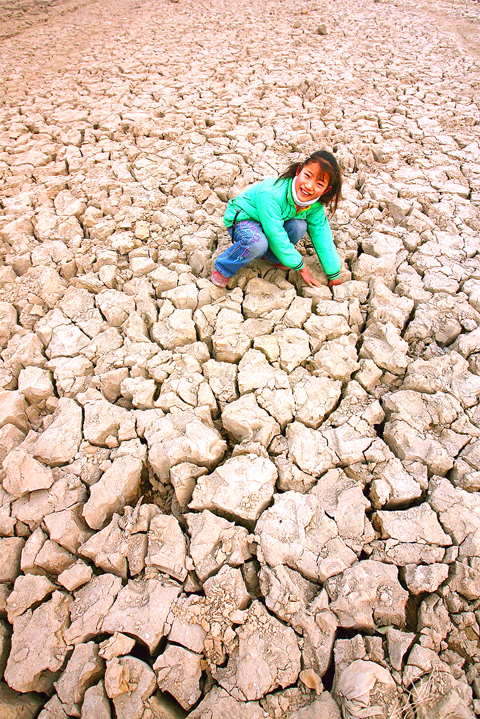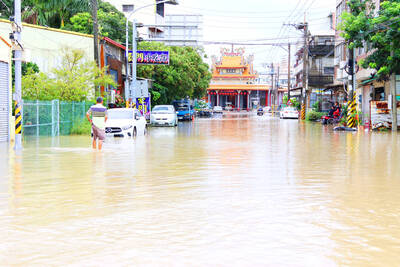China was struggling yesterday to get water to millions of people and save swathes of its wheat harvest, after raising its drought emergency status to the highest level for the first time.
The decision to go to emergency level one was taken on Thursday at a meeting of the State Flood Control and Drought Relief Headquarters, Xinhua news agency reported.
Eight provinces and municipalities are affected, stretching in a broad belt from Gansu on the Mongolian border in the northwest to Shandong on the Yellow Sea in the east.

PHOTO: AFP
About 43 percent of the country’s winter wheat supplies are at risk, as some areas have seen no rain for 100 days or more, state media said.
The increased alert level was made official at the same time as the central government sent out specialists to the major drought-hit regions to help residents with relief supplies and technical aid, the China Daily said.
About 4.3 million people and 2.1 million head of livestock are short of water, the relief headquarters said in a statement, as parts of the nation experience their worst drought since the early 1950s.
Chinese Vice Premier Hui Liangyu (�?}) held a state conference on Thursday to coordinate and strengthen efforts to help the affected regions, calling for quick financial and material support, the China Daily reported.
Hui also urged local governments to speed up the construction of irrigation systems for crops, the paper said, although it was unclear if this could be done fast enough to help alleviate the current crisis.
The dry spell highlights one of China’s main long-term worries, as water resources are becoming rapidly depleted due to fast economic growth.
Beijing, is particularly badly hit, with experts warning the city, home to 17 million people, will soon have reached the limit beyond which there will not be enough water to go around.
Last September authorities were forced into a six-month emergency diversion scheme that is seeing water being pumped from neighboring Hebei Province to Beijing.
The water flows along a 305km canal stretching from the Hebei capital of Shijiazhuang to Beijing and fed by three major reservoirs.
The canal is part of China’s ambitious North-South Water Diversion Project, a multi-billion dollar scheme to bring water from the nation’s longest river, the Yangtze, to the parched north.
Shaanxi Province, among the areas hardest hit by the drought, will try to induce rain or snowfall to relieve parched soil.
The province will time the effort to coincide with when a weak cold front from the Xinjiang Autonomous Region meets a warm stream from the southwest, the China Meteorological Administration said on its Web site yesterday. Local agencies will use rockets, cannon and aircraft to fire chemicals into the sky to seed the clouds and increase rainfall.
About 210 rockets and 400 cannons are in place, the report said. Airplanes will be deployed for man-made rains from late this month to next month, it said.

WAITING GAME: The US has so far only offered a ‘best rate tariff,’ which officials assume is about 15 percent, the same as Japan, a person familiar with the matter said Taiwan and the US have completed “technical consultations” regarding tariffs and a finalized rate is expected to be released soon, Executive Yuan spokeswoman Michelle Lee (李慧芝) told a news conference yesterday, as a 90-day pause on US President Donald Trump’s “reciprocal” tariffs is set to expire today. The two countries have reached a “certain degree of consensus” on issues such as tariffs, nontariff trade barriers, trade facilitation, supply chain resilience and economic security, Lee said. They also discussed opportunities for cooperation, investment and procurement, she said. A joint statement is still being negotiated and would be released once the US government has made

NEW GEAR: On top of the new Tien Kung IV air defense missiles, the military is expected to place orders for a new combat vehicle next year for delivery in 2028 Mass production of Tien Kung IV (Sky Bow IV) missiles is expected to start next year, with plans to order 122 pods, the Ministry of National Defense’s (MND) latest list of regulated military material showed. The document said that the armed forces would obtain 46 pods of the air defense missiles next year and 76 pods the year after that. The Tien Kung IV is designed to intercept cruise missiles and ballistic missiles to an altitude of 70km, compared with the 60km maximum altitude achieved by the Missile Segment Enhancement variant of PAC-3 systems. A defense source said yesterday that the number of

Taiwanese exports to the US are to be subject to a 20 percent tariff starting on Thursday next week, according to an executive order signed by US President Donald Trump yesterday. The 20 percent levy was the same as the tariffs imposed on Vietnam, Sri Lanka and Bangladesh by Trump. It was higher than the tariffs imposed on Japan, South Korea and the EU (15 percent), as well as those on the Philippines (19 percent). A Taiwan official with knowledge of the matter said it is a "phased" tariff rate, and negotiations would continue. "Once negotiations conclude, Taiwan will obtain a better

FLOOD RECOVERY: “Post-Typhoon Danas reconstruction special act” is expected to be approved on Thursday, the premier said, adding the flood control in affected areas would be prioritized About 200cm of rainfall fell in parts of southern Taiwan from Monday last week to 9am yesterday, the Central Weather Administration (CWA) said. Kaohsiung’s Taoyuan District (桃源) saw total rainfall of 2,205mm, while Pingtung County’s Sandimen Township (三地門) had 2,060.5mm and Tainan’s Nanhua District (南化) 1,833mm, according to CWA data. Meanwhile, Alishan (阿里山) in Chiayi County saw 1,688mm of accumulated rain and Yunlin County’s Caoling (草嶺) had 1,025mm. The Pingtung County Government said that 831 local residents have been pre-emptively evacuated from mountainous areas. A total of 576 are staying with relatives in low-lying areas, while the other 255 are in shelters. CWA forecaster